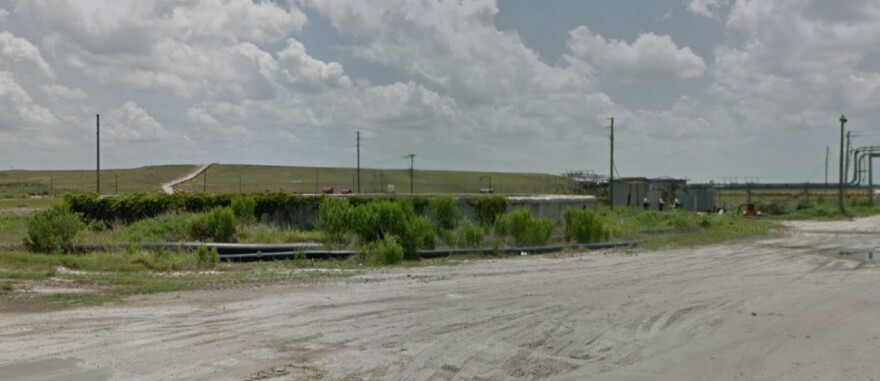A leak at a troubled phosphate processing plant in Manatee County could threaten Tampa Bay with a repeat of fish kills that happened a decade ago. Controlled releases at the plant began Tuesday afternoon.
The company running the former Piney Point plant, HRK Holdings, says water is leaking out of a pond inside a gypsum stack, which stores wastewater used in the production of phosphate fertilizer. The Department of Environmental Protection approved releasing an unknown amount of the water into Port Manatee, which leads into Tampa Bay.
Phil Compton of the environmental group Manasota-88 says the leak could lead to a failure of a dike, releasing millions of gallons of wastewater - including heavy metals and toxins.
"And if that were to happen, you would see annihilation of all plant and animal life downstream of wherever the stack lets go," Compton said. "And unfortunately, I think we're at that state where that's a possibility."
"You would see annihilation of all plant and animal life downstream of wherever the stack lets go."Glenn Compton, Manasota-88
State officials say they will authorize discharge into ditches that lead into Bishop Harbor, considered a pristine area of Tampa Bay, only as a last resort.
In 2001, a tropical storm forced the release of 10 million gallons of water into Bishop Harbor. Another 170 million gallons were released in 2011, killing untold numbers of fish and marine life in Tampa Bay after heavy rains caused part of the dike at the closed plant to collapse.
"We've been here before," Compton said. "Unfortunately, it's kind of the legacy that the phosphate industry leaves behind, that we are left with these phosphogypsum stacks, that really there's no economically sound or environmentally feasible way to get rid of these stacks or to cap them."
Congressman Vern Buchanan said in a tweet he was monitoring the situation.
I'm closely monitoring the situation at Piney Point in Manatee County, where a leak of contaminated wastewater is threatening the region. My office has been in touch with state environmental officials who are on site and working to contain the problem. (1/2)
— Rep. Vern Buchanan (@VernBuchanan) March 29, 2021
"This is a potential environmental disaster if it isn't handled properly. The Piney Point fertilizer plant was abandoned in 2001. Its contaminated phosphogypsum stacks remain a threat that needs to be resolved," he tweeted.
The Florida Department of Environmental Protection has overseen the removal of billions of gallons from the ponds. The department has used “spray evaporation” — spraying the water into the air — to get rid of the remaining water.
The agency has also treated water from the stacks with lime and reverse osmosis, then dumped it by barge in the Gulf of Mexico.
The pond where the leak happened holds an estimated 480 million gallons of mixed sea water — primarily saltwater from a Port Manatee dredge project, mixed with old process water and stormwater runoff and rainfall, said DEP spokeswoman Weesam Khoury.
"The department’s authorization for the controlled discharges is not a blanket authorization for the 480 million gallons. The Emergency Final Order only authorizes discharges at an amount necessary to ensure stabilization," she said.
Discharges are at a rate of an estimated 10,000 to 13,000 gallons per minute.
Here's a statement from DEP:
The department issued an Emergency Final Order requiring that HRK take immediate action and implement all necessary steps to ensure the integrity of the stack system and its lined impoundments and prevent an uncontrolled discharge. HRK and their third-party engineer have determined their actions are not able to prevent a catastrophic failure without a preventative controlled release. In accordance with the provisions of the Emergency Final Order, HRK has notified the department that they plan to begin dischargers to Port Manatee as a marine discharge location. Discharge to the existing outfall ditches is authorized only as a secondary option, to reduce or eliminate the amount of emergency discharge to Bishop Harbor, an Outstanding Florida Water.
HRK is notifying neighboring residents of their plans. This situation is evolving and we are happy to update you on a daily basis.
This follows HRK’s notification of the department last Thursday, March 25 (the same day observed), of a critical incident identified as part of their daily required monitoring of water levels at the site. They reported that they observed an increase in flow and conductivity levels in the drains that surround the gypstack at the site. HRK further notified the department, on March 28, that a boil (upwelling of water) was observed at the foot of the gypstack. At this time the cause of the leak is believed to likely be a liner tear in the NGS-S compartment. Over the weekend, flow levels and conductivity levels continued to increase, further suggesting a leak in the liner of the NGS-S lined compartment. To be clear, there is no evidence of any sinkhole activity or any geological abnormality.
The department was onsite Thursday and Friday (March 25 and 26) to meet with HRK and review the reporting information, and the company’s initial follow-up actions at the site. Department staff remained in close contact throughout the weekend. Department staff are onsite to oversee continued response activities by HRK and their third-party engineer to contain the leakage within the lined areas onsite. They have also initiated an investigation into the source and needed repairs to stop the leak.
DEP will continue our oversight of HRK’s follow-up response actions and efforts to protect the integrity of the stack system and contain any leakage onsite and will hold them accountable for fulfilling their obligations under department rules and their administrative agreement with the department regarding its duties as owner of the phosphogypsum stack system at the site.






